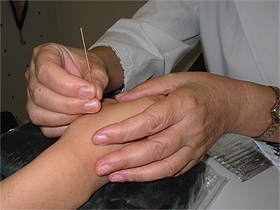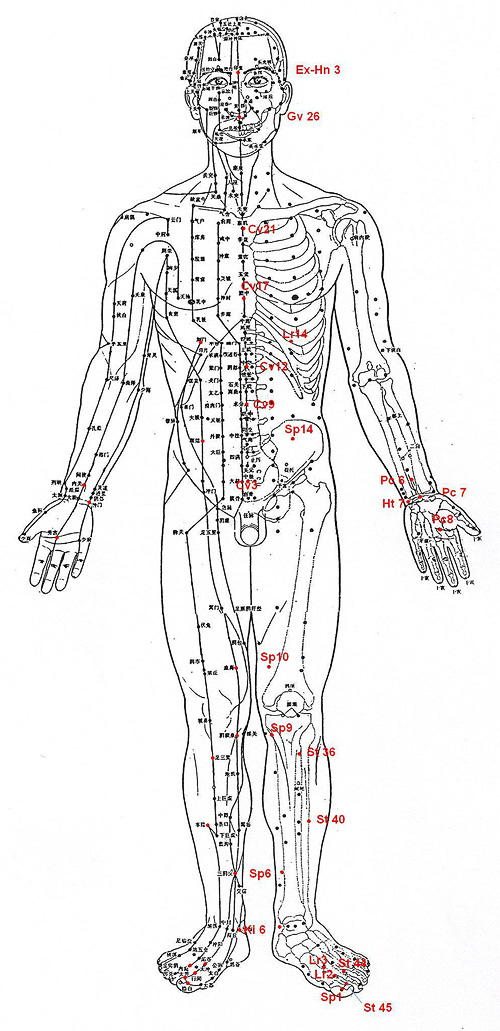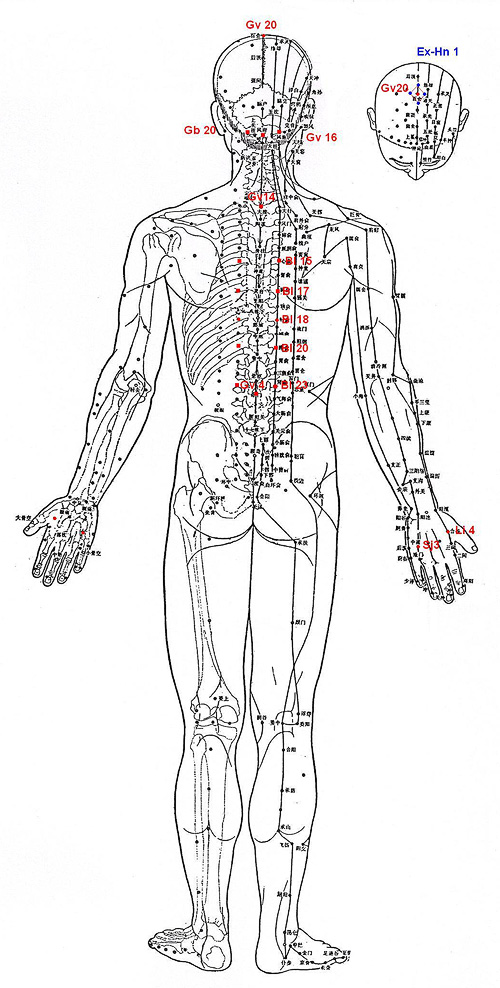Acupuncture and Moxibustion Therapies for Insomnia
Lack of sleep affects most of us at some time, but we are often unaware of the damage this lack causes. Chronic sleep problems take a toll on relationships, productivity and public safety. If your sleep problem lasts for over four weeks, you should seek the advice of a healthcare provider as often the problem can be easily diagnosed and treated. Insomnia is often associated with mental fatigue, emotional distress, or physical weakness.
 |
| Needling on the acupoint: he gu (Li 4) |
Acupuncture is often used in the treatment of insomnia and other mind disorders. In traditional Chinese medicine (TCM), mental activities are referred as shen (spirit), so insomnia is a manifestation of a shen (spirit) disorder in which various internal disharmonies makes the spirit restless and thus creates sleeping problems.
It is claimed that acupuncture has an advantage over herbal therapy in regulating shen and guiding qi movement . When needles are inserted at particular body points, there will be a dull ache, heaviness, distension, tingling, or an electrical sensation will be felt either around the needle or traveling up or down the affected meridian. While inserting the needles, the practitioner may experience tightness and dragging around the needle. TCM calls this deqi literally, the "arrival of qi", physicians try to obtain this needling sensation during acupuncture treatment. These various needling phenomena directly affect the neural regulating system inside the body, which helps clear up disturbances in the brain.
There is no general acupuncture remedy suitable for all insomnia sufferers. Appropriate point selection and stimulating techniques should be selected according to the diagnosed disharmony patterns. Clinically, TCM physicians classify insomnia into two major types:
 |
Excess type: the shen (spirit) is irritated by pathogens, such as phlegm, fire and dampness as well as blood stasis. This type of insomnia usually occurs in the disharmony patterns like liver stagnation or phlegm-heat harassment. Reducing techniques are adopted to eliminate the pathogens and suppress the hyper-functioning organs, and the needling techniques are generally rapid, forceful and long lasting. The body points are mainly selected along the stomach, liver, triple burner and governor vessel meridians. |
 |
Deficient type: the shen (spirit) is undernourished, with insufficient blood or qi. This type of insomnia occurs in those who have chronic illness or a sleep problem of long duration. The usual disharmony patterns are deficiencies of the heart and spleen or kidney yin deficiency. Reinforcing techniques are adopted to invigorate the bodyˇ¦s resistance and boost the under-functioning organs. The needling technique is generally slow, gentle and of short duration. The body points are mainly selected along the stomach, liver, heart and governor vessel meridians. |
Samples of acupuncture remedies for insomnia
| Presentation |
Difficulty in falling asleep or frequent waking up during the night. No obvious associated symptoms. |
| Therapeutic aims |
Regulating heel vessels and calming spirit to facilitate sleep.
In TCM, there are two extra meridians, the yin heel vessel and yang heel vessel, which dominate the activity and rest of the body and also control the opening and closing of the eyes. The yin heel vessel rules the body to rest and the closing of eyelids; the yang heel vessel rules the body to be active and the opening of eyelids. Since these two meridians do not have their own acupoints, physicians can only use their confluent points, zhao hai (Ki 6) and shen mai (Bl 62), to promote their functioning. |
| Body points and techniques |
 |
Zhao hai (Ki 6): the confluent point of the yin heel vessel. |
 |
Shen mai (Bl 62): the confluent point of the yang heel vessel. |
 |
Shen men (Ht 7): the source point of the heart meridian, it promotes the heart and calms the spirit. |
 |
Yin tang (Ex-Hn 3): regulates the governor vessel and clears the spirit. |
 |
Si shen cong (Ex-Hn 1): helps to calm the spirit. |
For Ki 6, twirl and rotate the needles with a reinforcing technique, while for Bl 62, twirl and rotate the needles with a reducing technique. For other points, apply even and gentle stimulation.
The above can be a basic prescription for all kinds of insomnia. This should be performed in the afternoon and at night before sleep for better results. |
| Presentation |
Difficulty in falling asleep, easily awakened or even wakefulness the whole night. Associated symptoms may include stress, anxiety, irritability, headache, dizziness, sighing, chest and abdominal distension. The tongue is red and the pulse is taut. |
| Therapeutic aims |
Dispersing liver, regulating qi movement, calming spirit to facilitate sleeping. |
| Body points and techniques |
 |
Tai chong (Lr 3): the source point of the liver meridian, this point can disperse the stagnated state of liver and regulate qi movement. |
 |
Shen men (Ht 7): the source point of the heart meridian, this point can regulate the heart functioning and calm the spirit inside it. |
 |
Gan shu (Bl 18): this is the back transport point of the liver, which is used to enhance the effects of tai chong (Lr 3). |
 |
He gu (Li 4): the source point of the large intestine meridian, it helps to regulate blood and qi circulation. |
 |
San yin jiao (Sp 6): belongs to the spleen meridian, but the liver meridian and kidney meridian intersect with the spleen meridian at this location. It is used to regulate the blood and qi circulation, invigorate the spleen and disperse the liver. |
Twirl and rotate the needles with a reducing technique.
When the associated symptoms are significant, nei guan (Pc 6), tan zhong (Cv 17) & qi men (Lr 14) can help to further relieve the physical discomforts due to qi stagnation in the liver. The above combination is also suitable for depressed individuals, and additional points like shui gou (Gv 26), nei guan (Pc 6) & feng fu (Gv 16) are selected to enhance the spirit-regulating effect. |
| Presentation |
Difficulty in falling asleep, easy awakened or wakefulness the whole night. Associated symptoms may include gastric fullness, belching, acid regurgitation, dry mouth or a change of taste in the mouth. The tongue coating is thick and greasy, and there is a rolling and rapid pulse. |
| Therapeutic aims |
Harmonizing stomach, enhancing the digestive process, calming the spirit to facilitate sleep. |
| Body points and techniques |
 |
Zhong wan (Cv 12): the alarm point of stomach, it can harmonize the stomach and enhance the digestive process. |
 |
Shen men (Ht 7): regulates heart functioning and calms the spirit. |
 |
Yin tang (Ex-Hn 3): enhances the calming effect of shen men (Ht 7). |
 |
Zu san li (St 36): this is an important point for stomach disharmonies. It is used to invigorate the spleen and stomach so as to smooth bowel movements. |
 |
Nei ting (St 44): this is the spring point of the stomach meridian; it helps to clear fire in the stomach. |
For zhong wan (Cv 12), insert the needle when the patient breathes in and withdraw the needle when the patient breathes out. For shen men (Ht 7), yin tang (Ex-Hn 3) and nei ting (St 44), twirl and rotate the needles with strong and quick skills. Apply even and gentle stimulation on zu san li (St 36).
In case of serious indigestion, fu jie (Sp 14) and xuan ji (Cv 21) are combined. When accompanied with stress or anxiety, nei guan (Pc 6) and tai chong (Lr 3) are used together. |
| Presentation |
Chronic insomnia with wakefulness the whole night. Associated symptoms may include sensitivity to low temperatures, dizziness, absentmindedness, and a weak pulse. |
| Therapeutic aims |
Regulating the governor vessel, warming yang, calming the spirit to facilitate sleep. |
| Body points and techniques |
Da zhui (Gv 14), bai hui (Gv 20), feng fu (Gv 16) and ming men (Gv 4), twirl and rotate the needles with a reinforcing technique, moxibustion is required for the points of da zhui (Gv 14) and ming men (Gv 4) during needle retention period.
All of them are important points along the governor vessel meridian, which has close relationships with the brain, spinal cord and kidney system respectively. Da zhui (Gv 14) is also the crossing point of the yang meridians; ming men (Gv 4) can regulate the primordial energy of the body; acupuncture and moxibustion on these two points help to reactivate overall functioning and promote body harmony. The acupoints bai hui (Gv 20) and feng fu (Gv 16) work together to calm the spirit. |
| Presentation |
Insomnia, irritability, dizziness, ear ringing, lumbar soreness, knee weakness, hot flashes, night sweating and seminal emission. The tongue is red, and there is a thready and rapid pulse. |
| Therapeutic aims |
Nourishing yin, clearing heart, promoting the communication between the heart and kidney system to facilitate sleep. |
| Body points and techniques |
 |
Shen men (Ht 7): promotes the heart and calms the spirit. Twirl and rotate the needle with a reducing technique. |
 |
San yin jiao (Sp 6): nourishes the kidney. Twirl and rotate the needle with a reinforcing technique. |
 |
Shen shu (Bl 23): the back transport point of the kidney, which can promote it communicating with the heart. Twirl and rotate the needle with a reinforcing technique. |
 |
Xin shu (Bl 15): the back transport point of the heart, which can promote its communication with the kidney. Twirl and rotate the needle with a reducing technique. |
 |
Feng chi (Gb 20): this point can regulate blood and qi circulation in the head region, and helps clear the mind. Lift and thrust the needle with a reducing technique. |
 |
Tai xi (Ki 3): the source point of the kidney, which is used to promote kidney yin. Twirl and rotate the needle with a reducing technique. |
The above combination is suitable for insomnia during menopause. Additional points can be selected for severe accompanying symptoms, for example, sweating, select points like fu liu (Ki 7) and he gu (Li 4); for hot flashes select lao gong (Pc8); for ear ringing select ting hui (Gb 2) and zhong zhu (Sj 3); and for puffiness select shui fen (Cv 9). |
| Presentation |
Dream-disturbed sleep, frequent nightmares, palpitations, forgetfulness, paleness, sweating, fatigue and poor appetite. The tongue is pale, and there is a thready and weak pulse. |
| Therapeutic aims |
Invigorating the spleen and heart, replenishing blood to facilitate sleep. |
| Body points and techniques |
 |
Shen men (Ht 7): promotes the heart and calms the spirit. |
 |
Pi shu (Bl 20): the back transport point of the spleen, which is used to promote blood production. |
 |
Xin shu (Bl 15): promotes heart functioning. |
 |
San yin jiao (Sp 6): promotes spleen functioning. |
 |
Zu san li (St 36): promotes spleen functioning. |
 |
Yin tang (Ex-Hn 3): regulates the governor vessel to clear the spirit. |
For tin tang (Ex-Hn 3) applies even and gentle stimulation, the other points are stimulated by twirling and rotating the needles with a reinforcing technique.
Serious nightmares indicate that the spleen and heart need an extra boost; in this case points such as yin bai (Sp 1), li dui (St 45) & da ling (Pc 7) are selected. For other accompanying symptoms, feng chi (Gb 20) & si shen cong (Ex-Hn 1) are selected to enhance the circulation in the head and relieve headache and dizziness; nei guan (Pc 6) & ge shu (Bl 17) regulate the heart and relieve palpitations; feng fu (Gv 16) & bai hui (Gv 20) clear the mind and promote memory; ge shu (Bl 17), xuan zhong (Gb 39) and xue hai (Sp 10) enhances blood production and relieves anemia. |
Moxibustion therapy for insomnia
In some cases, moxibustion is indicated along with acupuncture to activate qi and blood flows in the meridians. For each treatment, choose one to four acupoints, and warm with a moxa stick for 5-15 minutes at each point.
|
| Warming with a moxa stick on yung quan (Ki 1) |
Insomniacs can also use moxibustion at home. Acupoints on the feet such as yong quan (Ki 1, center of the soles) and zhao hai (Ki 6, inner side below the ankle bones) can be stimulated to promote sleep. Every night before sleep, soak the feet in warm water for ten minutes, and then use a lit moxa stick to warm the above acupoints, 10-20 minutes on each side.
Another way is warming bai hui (Gv 20, center of the head crown) and yong quan (Ki 1), which promotes qi circulating throughout the body. Do this in the afternoon and before sleep; stimulate for 20 minutes.
 |
 |
Body points for insomnia |
|